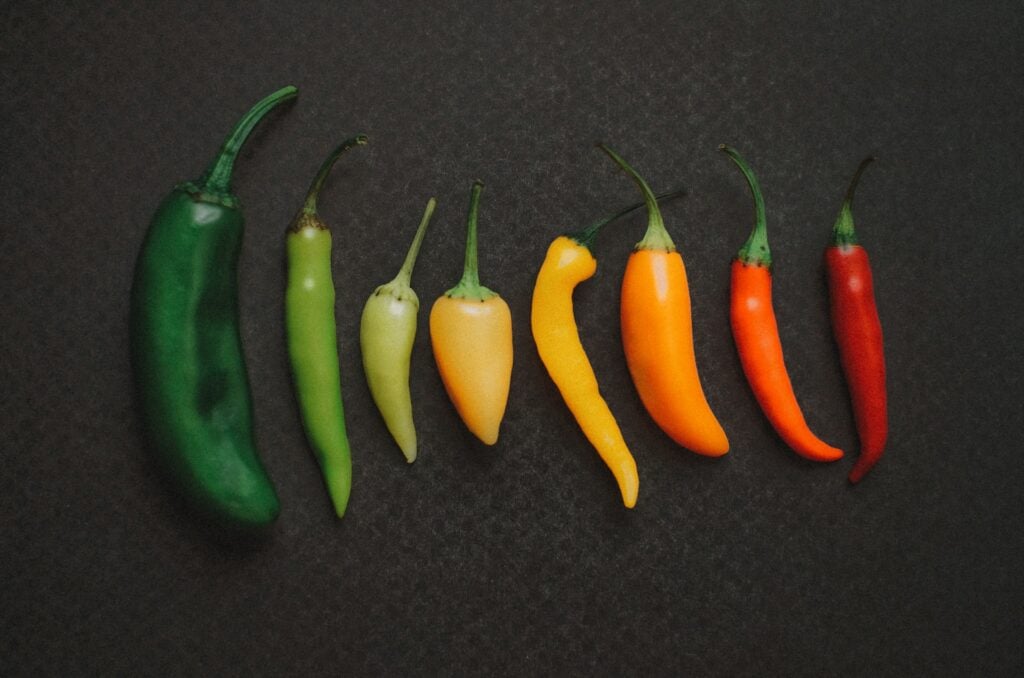Understanding the Different Types of Spicy

Do you like spicy food?
Spicy food is found in cuisines all over the world. However, all spicy foods are not created equally. There are many different types of spicy food, and they are all unique and delicious in their own ways. Understanding the types of spicy can help you strengthen your relationship with food, and let you find the foods you love the most (and which ones you’d rather avoid).
The levels of spicy can range from just a hint of heat to full-on sweating and running to the nearest glass of water. Different palates perceive spice levels differently, but most people agree that spicy food adds another dynamic to a meal.
What Is Spicy Food?
Spicy food, simply put, has one or more of the chemical compounds found in nature that give food a spicy flavor or sensation. Many people in the world have never contemplated what is spicy food because it is so common throughout many cultures. There are several different types of spicy food, and the flavors they present depend on which compounds the foods contain. Some foods are naturally spicy like peppers and horseradish, and others can be made spicy by adding compounds to them.
The list of spicy foods you can tolerate will be different from other people, and the only way to know is to try different types of spicy food, and see which ones you like.
What Are the Different Types of Spicy?
The term “spicy” can be given to a few different culinary sensations in food. When asked “what is spicy food” most people tend to think of the hot burning sensation that comes from peppers, but there are a number of different compounds that produce different types of spicy.
Here are some of the compounds that produce different types of spicy:
- Capsaicin is the compound responsible for the sensation present in hot peppers.
- Allyl Isothiocyanate is the compound that gives mustard, wasabi, and horseradish their spicy flavors
- Piperine is the terpene that gives spice to black pepper
- Allicin is the chemical compound that gives raw garlic and onions their spicy flavor
- Gingerol is the phytochemical compound that gives fresh ginger it’s spice
- Cinnameldahyde is what gives cinnamon it’s flavor, even though not everyone perceives the flavor as spicy
- Hydroxy-Alpha-Sanshool creates the numbing or tingling sensation found in Sichuan peppers and uzazi
There are many different types of spicy foods from around the world. Some common ones include:
- Mexican cuisine uses chili peppers and cumin to add heat to dishes like tacos and enchiladas.
- Indian cuisine often uses a blend of spices like cumin, coriander, and chili powder to create dishes like curry and tandoori chicken.
- Szechuan cuisine, which is known for its use of Szechuan peppercorns and chili peppers to create dishes with a numbing, spicy flavor.
- Thai cuisine uses chili peppers, lemongrass, and ginger to create dishes like tom yum soup and green curry.
- Korean cuisine often uses chili peppers, garlic, and gochujang (red pepper paste) to create dishes like kimchi and bibimbap.
List of Spicy Foods
Peppercorns & Chilies
Jalapeno: Probably one of the most widely known spicy foods out there, jalapenos can have their spice levels controlled by the way they are prepared. For instance, pickled jalapenos are significantly less spicy than fresh jalapenos.
Peppercorns: While many people may not regard black pepper as “spicy,” peppercorns are a great way to add a hint of spice to a dish while still complimenting the other flavors.
Gochujang: A slightly sweet, yet still spicy chili paste made from soybeans typically found in Korean dishes like Bahn-Mi and Bibimbap.
Szechuan Peppercorn: This delightfully spicy peppercorn deliver a slight tingly/numbing sensation. Szechuan peppercorns make a great addition to chicken or can elevate a cocktail.
For the home cook looking to spice things up, check out our list of must-have spices to keep in your pantry.
Brassicaceae
Mustard: While not always spicy, mustard seeds can add a tremendous amount of spicy flavor to a dish. Spicy mustard pairs excellently with meat, cheese, and vegetables. Whole-grain mustard is considerably spicy than traditional yellow mustard.
Wasabi: Related to horseradish, wasabi delivers a short-lived heat that goes great with the sweetness of sushi or as a condiment for teriyaki chicken.
Horseradish: Known for its hot, pungent flavor, horseradish root packs a quick punch of spice that can punch up fish, beef, or oysters. While the flavor is intense, this type of spicy doesn’t last long on the palate.
Ginger: Another root that provides a quick burst of warm heat, ginger makes a delightful addition to tea or stir-fry. Ginger can also be used in sweet applications like cookies and cocktails.
Pepper Sauces
Siracha: This bottle of bright red sauce with a rooster comes from Thailand, and brings a slightly sweet, yet still spicy flavor to vegetables, chicken, and more. Sriracha is made from chili peppers, vinegar, garlic, sugar, and salt.
Tabasco: Tabasco sauce is made from tabasco peppers, vinegar, and salt. Tabasco is one of the most popular hot sauces in the US and can be found in most restaurants in order to spice up any dish.
Harissa: This North African hot sauce is made with hot red peppers, oil, and garlic. Harissa makes a great addition to chicken, beef, vegetables, and even scrambled eggs.
For more options check out our hot sauce guide.
Ready to Kick Your Meals Up a Notch?
There are many ways to incorporate different types of spicy food into your diet. Whether you are cooking with spicy peppers or roots or having spicy meals delivered right to your door, spicy food brings another dimension to your dinner table. Even if you think you can’t handle spicy food, start with moderate amounts and see if you don’t change your mind!
With Gobble, you can taste all the different types of spicy with our globally inspired menu that rotates weekly with fresh recipes. Try the Classic Plan, our Vegetarian Plan, or our Lean & Clean Plan if you want nutrient-rich meals always under 650 calories per serving.



